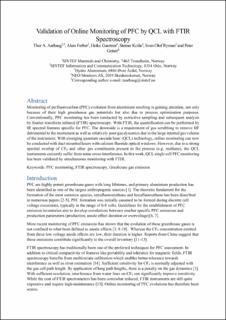Validation of Online Monitoring of PFC by QCL with FTIR Spectroscopy
Aarhaug, Thor Anders; Ferber, Alain Marc C; Gaertner, Heiko; Kolås, Steinar; Ryman, Sven Olof; Geiser, Peter
Peer reviewed, Journal article
Accepted version
Permanent lenke
https://hdl.handle.net/11250/2690319Utgivelsesdato
2018Metadata
Vis full innførselSamlinger
- Publikasjoner fra CRIStin - SINTEF AS [5643]
- SINTEF Industri [1532]
Sammendrag
Monitoring of perfluorocarbon (PFC) evolution from aluminium smelting is gaining attention, not only because of their high greenhouse gas potentials but also due to process optimization purposes. Conventionally, PFC monitoring has been conducted by extractive sampling and subsequent analysis by fourier transform infrared (FTIR) spectroscopy. With FTIR, the quantification can be performed by IR spectral features specific for PFC. The downside is a requirement of gas scrubbing to remove HF detrimental to the instrument as well as relatively poor gas dynamics due to the large internal gas volume of the instrument. With emerging quantum cascade laser (QCL) technology, online monitoring can now be conducted with duct mounted lasers with calcium fluoride optical windows. However, due to a strong spectral overlap of CF4 and other gas constituents present in the process (e.g. methane), the QCL instruments currently suffer from some cross-interference. In this work, QCL single cell PFC monitoring has been validated by simultaneous monitoring with FTIR.
